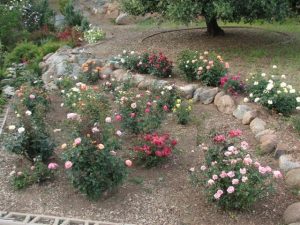The Tuolumne Utilities District noted recently that, if we all do our part and use less water, we just may just get through the drought this summer. With the many repairs needed to fix our leaky system and the constant water demands, are we gambling with our water resources? Can the purchase of additional water from New Melones reservoir, along with rigorous conservation, be the help needed this year?
This is the month that most outside water is consumed. To help us become more aware of this, July is designated Smart Irrigation Month. Thirty percent of our water is used outdoors and, with current methods, fifty percent is wasted. Consider these tactics for saving water in your yard:
- Water at night, ideally between midnight and 6:00 am. This reduces evaporation and the wind will not be strong enough to interfere with sprinkler patterns.
- Replace turf with ground covers, mulches, decks and walkways. Water remaining turf infrequently but deeply. Make sure that water penetrates down to 8 inches below the surface and set lawnmower blades at a higher level. This results in deeper roots and higher turf shades the soil to reduce weeds.
- Mulch liberally.
When I was a student in the UCCE Master Gardener program, a UC Davis professor told the class that he used mulch everywhere. When he said that he watered his tomatoes every three weeks, I almost fell out of my chair and asked him to repeat that fact. My tomatoes were wilting every other day unless I watered them. I found that the use of a 3 to 4 inch layer of mulch makes a huge difference and keeps the garden looking quite alive. Over time, the mulch deteriorates and adds nutrients to the soil.
Here is another testimony to the benefits of using mulch. Two years ago, I helped build a park and applied 4 inches of mulch. Now, there are hardly any weeds in the park and, even with this hot, dry year, a multitude of acorns are pushing up oak tree sprouts – testimony that the area is retaining moisture, despite a lack of irrigation.
Water conserving for edible gardens:
- Determine that local water allocations are sufficient to allow an edible garden.
- Plant shorter season crops and drought-resistant varieties.
- Remove weeds, which compete for water resources.
- Install a water-efficient drip system.
- Irrigate early in the season to keep fruit and nut trees alive. With limited water, thin or remove fruit to reduce stress on the trees.
- For ornamental trees, one or two deep irrigations several weeks apart in spring and summer will often keep them alive. Leaves will drop or wilt in a severe water shortage but, with appropriate care, trees will survive.
Here are four basic water-saving techniques:
- Grow a smaller garden.
- Grow edibles that mature quickly and are drought tolerant.
- Compost and mulch, mulch, mulch.
- Use smart irrigation strategies, such as watering early in the day.
The severe drought that California is experiencing has forced us to reconsider how we garden. Trying to keep a water-thirsty English-style garden just won’t work in our water-strapped environment. By considering the techniques listed above, we can all sustain a beautiful, California style garden and save our precious water resources.
Jim Gormely is a University of California Cooperative Master Gardener of Tuolumne County and lives in Columbia.


